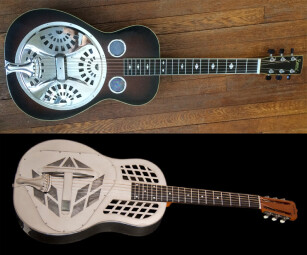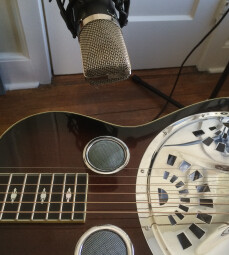Resonator guitars are most often heard in blues, bluegrass, and country music, and offer a unique tone that can add real spice to a recording. In this article, I'll take a quick look at the history of these instruments, talk about the different types of resonator guitars, and discuss how to record them. I’ll also offer some sonic and video examples
History lesson
The resonator guitar was invented in the late 1920’s, before the advent of the electric guitar. At that time, live bands featuring horn sections were very popular across the country. The guitarists in these bands had a real problem, though; their acoustic guitars got drowned out by the rest of the band, especially the horns. So an enterprising musician named George Beauchamp asked his friend John Dopyera to design a louder guitar. Dopyera came up with the idea of a metal-bodied guitar that had three metal cones inside in the body under the strings. This was what’s now referred to as a Tricone resonator. The cones amplified the sound considerably, although the tone became a lot more midrange heavy.
Beauchamp and Dopyera formed a company and manufactured Tricones under the brand name National. The following year, Dopyera and his brother formed another company, Dobro (the name is a combination of “Dopyera” and “Brothers”), which made resonators that featured one large single metal cone and a wood body. These “Dobros, ” were both louder, and less metallic sounding than the original National Tricones.
Over the years metal-body resonators like the Tricone and single-cone models became associated with blues playing. They were played like an acoustic guitar, but often with a slide.
At some point after the Dobro was invented, wood-body resonators started being manufactured with square necks, and the action raised up by about an inch off the fretboards. Tuned to an open tuning, these were typically played lap-steel style, that is, flat on the lap with a steel bar used as a slide. The frets are only there as markers on these instruments, as the strings never actually touch the fretboard. Square-neck wood-body resonators have become popular over the years in bluegrass, “new acoustic” music and in country.
Miking tips
As with any guitar, it’s good to experiment with different mic positions to try to find the one that sounds best for the song you’re recording. That being said, here are some starting points:
You can get the most midrangey and distinctively resonator tone by aiming the mic at the cone itself. Start with it around five or six inches away and move it back and forth and side to side until you find the best tone. You might find this to be too extreme a sound on some instruments.
Resonator guitars usually have a couple of sound holes in addition to the cone — on wood body resonators they typically have wire mesh over them, although sometimes they’re open. On metal body instruments they can be in the form of “f” holes or some other shape. In any case, these are very good miking points. In fact, on the wood body resonator, I’ve found them to be the best place to mic the instrument, especially when the guitar will be played lap style.
Another successful spot to point the mic at is where the neck meets the body, like you’d do on an acoustic guitar. This gives you the least amount of resonator tone of the three positions mentioned. If you think of the three as being on a continuum, then aiming the mic at the cone provides most extreme resonator sound, at the sound hole less so, and the neck/body junction is the least. In terms of mic choice, large diaphragm condensers work great as do pencil condensers.
Take a listen
Now, to demonstrate what I’m talking about, here are several examples. In all three, you’ll first hear the mic placed at about 6” from the instrument and then the passage will repeat with the mic placed at 12” from the instrument. To make it easy as possible to compare the sounds of the different positions, I played the same passage in all the examples. The instrument was a Beard R Standard wood-body resonator. It was miked in all instances with a Mojave Audio MA-300 tube mic.
Here, the was mic aimed at the center of the cone. This has the most midrange-heavy sound:



Overall, I’ve found wood body resonators, played lap style, to be much easier to get a great sound from. Metal body instruments take more work and experimentation, and it also depends on whether they’re being strummed, finger picked, and/or played bottleneck style. They produce very complex tones and you can get a lot of variation with different mic placements.
Great players in action
If you want to see a couple of masters playing resonator guitars, check out the following two videos. The first is of Jerry Douglas, who mainly plays a wood-body resonator, and is considered the “Jimi Hendrix of the Dobro, ” thanks to his combination of technique, originality, and great taste.
The late great Johnny Winter was an excellent metal-body resonator player for blues. Check him out on this video.


